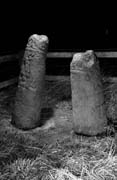Select a site alphabetically from the choices shown in the box below. Alternatively, browse sculptural examples using the Forward/Back buttons.
Chapters for this volume, along with copies of original in-text images, are available here.
Object type: Part of round–shaft [1]
Measurements: H. 97 cm (38.5 in); Circumference 127 > 109 cm (50 > 43 in)
Stone type: Pale red (5R 6/2), medium- to coarse-grained, clast-supported sandstone. Grains range from 0.3 to 0.8 mm, but mostly 0.4 to 0.5 mm (medium-grained); most grains are quartz, but there are a few, scattered, pink, ?feldspars. Millstone Grit Group, Carboniferous
Plate numbers in printed volume: Ills. 162-6
Corpus volume reference: Vol 9 p. 78-9
(There may be more views or larger images available for this item. Click on the thumbnail image to view.)
The earliest explicit reference to the presence of pillars (plural) at this site is in a diary entry by Viscount Byng in 1793 (Andrews, C. 1936, 119–20). Much earlier, in a Lyme manuscript of 1465 (Rentals of Lime ... in the possession of Peter Legh, Knight, fol. 272) is a passage which mentions 'le lapide vouatt [= vocatum] le Borestone' in a context which can be identified with the position of the present monument (Dodgson 1970a, 199; id. 1981, xvii; Parsons and Styles 1997, 126–7: O.E. '*bor' interpreted as 'thing in a conspicuous position; prominent object'). Marshall, following Bu'lock, has argued that the singular form 'le Borestone' recorded in 1465 cannot refer to the present double shafts (Bu'lock 1957, 31; Marshall 1975). She went on to suggest that they were introduced to their present position at some post-medieval date and that the two 'Bow stones' originally belonged with the shafts and fragmentary cross-heads now forming Disley Lyme Hall 1, 2 and 4; all, she suggested, were part of a composite monument which stood in the large double socket, Disley Church Field 1.
The argument is carefully made and may well be correct, though none of the reasons given are individually totally convincing. In particular her case fails to account for the appearance of a double socket with round-shafts at precisely the point occupied by 'le Borestone' in 1475. Moreover, the singular form of reference in the Lyme manuscript may be explained by the composite structure being viewed as a single monument which, by that date, had lost its cruciform topping; in this context it is worth recording that no less than three major nineteenth-century writers, Marriott, Ormerod and Earwaker, variously described the stones or captioned their engravings as 'The Bow Stone' (Marriott 1810, 355; Ormerod 1819, III, 282 and fig, on 419; Ormerod 1875–82, I, 540; Earwaker 1877–80, II, fig. on 285). Marshall's further assertion that the present socket (no. 3 below) is too shallow to have offered a firm foundation to a full-height cross seems to be contradicted by the Lysons' exact measurement of the socket depth as 11 in (28 cm), which would be perfectly adequate for this purpose (Lysons 1810, 459).
In favour of the suggestion, however, is the fact that the measurements of the Lyme Handley and Lyme Hall stones do not run counter to the proposal that they could have once formed part of two complete crosses and, more positively, their lithology is also identical. Given that the Lyme Hall stones may well have come from the Church Field site, this might seem to add up to a strong case for arguing that this was the original site of Lyme Handley 1 and 2. Yet, if we accept this, then we must recognise that the socket-stone at Lyme Handley (no. 3 below) is geologically of a piece with the two columns now set in it whilst the Disley Church Field socket is totally unlike any of the other stones, being different in colour, finer grain size and better sorting (p. 73). The problem thus remains, though it should be emphasised that, whether deriving from Church Field or originally erected on their present moorland site, neither of the Lyme Handley stones came from a churchyard.
The cylindrical shaft has been re-cut to give it a rounded top carrying a small socket, 8 x 8 cm (3.5 x 3.5 in). Above an encircling moulding at the top of the surviving stone are traces of knotwork, or possibly scroll, running round the shaft. On the east face is an incised cross set above a second symbol consisting of a vertical member linking two horizontal incised lines; above are the letters W L.
Round-shaft (see Chapter V, p. 33). If the stone is in its original position in a double socket, then it can be compared with local examples inferred from the double round-sockets of Disley Church Field and the Ludworth (Derbyshire) 'Picking Rods' (Ills. 160–1; Sharpe 2002, 13, 93). The seeming scroll or interlace decoration above the single moulding suggests that the shaft may originally have carried a broad band of bordered decoration of the type seen on Disley (Lyme Hall) 2, inferred at both Astbury 1 and Macclesfield St Michael 4, as well as evidenced complete at Leek in Staffordshire (Ills. 20–2, 167–70, 189–93; Kendrick 1949, pl. XLIV). The letter 'W' may refer to Sir Ralph Wyttle who, as priest of Disley, withdrew from his benefice in 1541; the 'L' is presumably a marker of the Leghs of Lyme who had control of the estate by the sixteenth century (Marshall 1975, 71–3).



